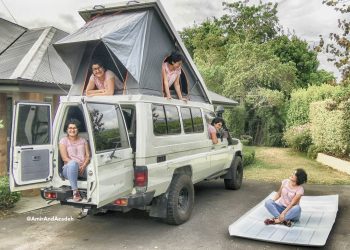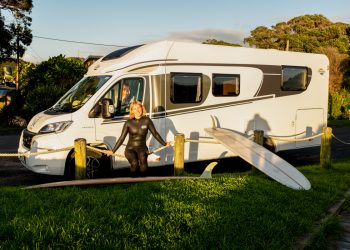The electrical system of a camper is probably the defining point that transforms a vehicle into a camper. At first these systems can seem incredibly complicated and intimidating. They aren’t and they have been around for a very long time. The basic system is identical to that used in recreational boating.
From a simple van to an 8 berth, have the same basic foundation electrical system.

The vehicle’s motor is generating electricity as it’s running, this is what keeps your car battery charged and powers your lights, stereo etc. You can even, easily up the electrical output by getting a larger alternator.
A standard car battery is designed for the quick jolt of starting a vehicle engine, they are also known as cranking batteries. They aren’t so great sitting around with nothing coming in and having accessories draw electricity from them. Deep cycle batteries, also known as house batteries, on the other hand, are designed to be slowly charged up and then handle a constant discharge.
The most common system is to add a new circuit which incorporates a deep cycle battery/s that takes that excess electricity generated while the motor is running and stores it in the deep cycle battery/s. The house lights, fridge, USB sockets etc are connected to this circuit. A charge isolator is put in the circuit between the car battery and the deep cycle so the house circuit can’t start drawing on the car battery. This protects the cranking battery so the vehicle can always be started.
The term house battery comes from fact that the house [the living/sleeping area of your camper] is powered off this deep cycle battery.
From this basic system everything grows. Want more power to stay longer, simply add more deep cycle batteries. Want to charge a laptop? Add a pure sine wave inverter. Want more power coming in? Add solar panels to top up the deep cycle batteries while you are stationary.
Here’s a good power set up from our Aussie mate Michael at Seek Adventure
Check out his channel, there’s heaps of useful tips even if you’re not 4x4ing.
And to hammer it home here’s another Aussie clip using Redarc products which are readily available in NZ
Shore Power [see there’s that boating thing creeping in again] is the next most common source of camper electricity. If you’re planning to stay at powered campsites then shore power is almost a no brainer. Shore power is the socket you see on the sides of campers that allows them to plug in to 240v sources like those power posts you see at campsites.

If you are DIY’ing do not attempt to do any 240v wiring yourself. Campers with shore power require an Electrical Warrant Of Fitness [effectively a certificate of compliance and fitness.] Campsites are not allowed to let you plug in unless you have a current [dad joke] EWOF. A special weather proof 3 pin cord is needed and a Residual Current Device [RCD] is built into the circuit to stop a fatal shock.
Having a 240v system on board allows you to run high wattage drawing domestic appliances like an oven or an electric heater. Usually the 240v system will also feed into a good battery charger that tops up the house battery and in turn runs the house lights and other 12v accessories.

Solar Panels; solar technology is ever evolving and even as you read this there will be exciting new solar products available that weren’t at the time of writing. One day we’ll all be driving electric campers that create enough energy to run the motor and power all the accessories and appliances you want. Perhaps the electric generating solar cells will simply be the paint job of your camper. It’s coming.
Here’s a great American clip that simply explains how it works
Present day, solar panels are incorporated into just about every professionally built and DIY’d camper. You can pick up an excellent kit online for …yep…about $1000.00 nzd. A standard set up would be about 200w of panels.
Not all panels are created equal. There are three basic types of solar cell. The first two are; Monocrystalline cells which are cut from a silicon ingot grown from a single large crystal of silicon whilst polycrystalline cells are cut from an ingot made up of many smaller crystals. These are the rigid type panels you probably think of when you think solar. They are extremely rugged and durable and run at nearly 20% efficiency. They need to be in direct sunlight to work at all. Say it’s a cloudy day or you’re parked under trees, they simply will stop working if they are 40% covered by shade.
The third type is the amorphous or thin-film solar cell. These are the bendy ones you’ll find that look nice and thin. Often they are simply glued to a roof.
Amorphous cells are made by depositing a thin film of silicon onto a sheet of another material such as thin, mild steel. The panel is formed as one piece and the individual cells are not as visible as in other types of solar panels. The efficiency of amorphous solar panels is about 12%. Amorphous solar cells have a much shorter lifespan and aren’t as rugged as the tempered glass covered rigid ones. But they will continue working on cloudy days.
So the game here is; a more efficient panel that gathers sun power better while the sun is out, or a panel that trickles in power all day long no matter what. Most people opt for rigid ones for ruggedness and longevity.
Every camper’s dilemma is valuable roof space. Where do you stow gear if the panels are claiming all the roof. There are options like briefcase, folding panels that you can store inside the camper and then set up and plug in once you’re making camp. There are Amorphous blankets that you can set up behind the windscreen. These all work, and are cheaper than having permanently roof mounted panels, but of course add another stage to camp set up and break down. It is pretty satisfying sitting out the back knowing that your solar set up is trickling in power to keeping your devices charged and snack chilled.
Camper Tip; Staying at a campground and they offer you a nice site under the trees? Don’t take it! Ask for one in the clear, apart from now being a lover and gatherer of solar amp hours, birds seem to always roost in campground trees. Birds love nothing more than to crap on your roof, solar panels and awning, plus trees seem to wanna shed leaves and twigs and drip water all over your mean-as rig. Make your own shade. Check out post on awnings HERE.
And to counterpoint even getting solar power at all…
Electric Lithium Generators. Over the last few years portable plug and play ‘Generators’ have become an increasingly good option. These aren’t as complicated as they sound. Pretty much all they are is a box or enclosure that houses a similar circuit to an RV foundation circuit ie power comes in from a source, it’s stored in a battery inside the box and then on the outside of the box there will be a voltmeter and a variety of outputs like USB and Cig [abbreviation of cigarette lighter style]. The better ones also contain a pure sine wave inverter for 240v output.
You can even buy pre wired enclosures and install your own deep cycle battery. They can be charged from your home, the vehicle and solar.
The huge advantage of these is that you can remove box from the camper for other uses like if there’s a powercut at home. And of course you can simply transplant the box from one camper to your next. Generally, and this is very generally, they cost more than a simple permanent circuit installation.
Old acid house [not the music] batteries VS Lithium batteries; Again technology is moving fast here so it would pay to check updates. Traditional house batteries work on a 150 year old process of tried and tested acid immersed lead cells which store the power. Mostly these are now sealed units so there is not much chance of leaking corrosive battery acid. But they still have to be vented to let off hazardous gases created by the process. They work well, but you can only use the top 50% of the stored power. If you drain an older battery below 50% it will be ruined and won’t be able to be recharged. In fact a lot of experts recommend only drawing 30% . Also their life cycles are quite short, you can only charge [cycle] them about 500 times or 2 years, we could get into the inefficency of the way they charge too, but you don’t really need to know that. Because they have been around a long time they are relatively cheap to buy. About $500.00 will get you an excellent 120-160 Amp Hour deep cycle battery. In real life terms this would comfortably run a chest fridge, LED lights and a couple of phone charges for 3 days.
Lithiumn Ion Batteries
Lithium-ion batteries are a third the weight but cost 4x that of a similar Amp hour acid battery [this is ever dropping though]. Lithium-ion batteries are nearly 100% efficient in both charge and discharge, allowing for the same amp hours both in and out. Lithium-ion batteries are discharged 80% versus 30-50% for lead acid. They cycle 5000 times or more compared to just 400-500 cycles in lead acid. Lithium-ion batteries maintain their voltage better throughout the entire discharge cycle. This allows for greater and longer-lasting efficiency of electrical components. Lithium-ion batteries are a much cleaner technology and are safer for the environment. They don’t have to be stored upright, they are lighter. If you have the money up front it’s the way to go; over ten years an acid battery system will cost you more, plus you have to be a lot more vigilant on the maintenance.
If your existing house batteries are about to die, then Lithium is a huge consideration. If you’re buying a second-hand camper, check the age of the house batteries, you could be in for a big bill straight off the bat.
Petrol and Diesel Generators
Portable fuel generators are a combustion engine housed in an enclosure with circuitry to convert that combustion into electricity. They are a way of getting juice when shore power hook-ups are not available, it is important to use them in consideration to fellow campers – it is still an engine running. Generators are available in a wide range of outputs, generally one rated in the 300 to 900 kilowatt range is all a camper needs. Not all generators are suitable for use with campers so do some research selecting the right option.
Bigger RV’s often carry portable generators. Some even have a dedicated storage area that are hardwired in and vented. They are ever dropping in cost too. Smaller ones are just over the size and shape of a plastic 20litre petrol container and pretty quiet compared to the older dungas. If you’re planning on going on extended adventures off the grid or need a large amount of power for your creature comforts they are certainly a consideration.
Got It, Don’t Waste It
You’re making power, you’ve now turned into a full Amp Hour hoarder, the next logical step to save that power is to reduce your usage.
LED lighting has been quite a revolution for campers. LED’s draw ¼ the power of a similarly rated incandescent bulb and are now the go to for every camper. If you are renovating an older camper, this will be one of your first ports of call. There are a ton of LED bulbs [units] available that are made to fit existing bulb mount sizes, so chances are you’ll just be swapping out the old bulbs, for new expensive LEDs that cost 6 times more, but with last 25 times longer. If you are DIY’ing from the start then LED’s are just a no brainer.
LED strips are super popular in campers as they provide a really nice ambient light source that can be run around the roof. There are LED strips readily available that are USB connected, perfect for campers.
Avoid up and downing your current; Older laptops are a good example, they typically run a 19v battery. To charge it you need a 240v power source. That box on your laptop’s power cord down cycles the 240V down to 19V. So in a camper you’re using your inverter to take the 12v power from your house battery to take it up to 240V so the Laptop’s cord can take it back down to 19V. At every stage electricity is used and wasted. If you have a newer USBC charging laptop, no problem as this will charge directly off your 12V with no cycling up and down. Consider taking away a tablet and double purposing it as your entertainment screen in the evenings. Use a USB charger to recharge camera batteries instead of a 3 point mains plug.
A well installed and maintained power system should never fail, despite this most campers do become back up obsessed and often reduce their power useage by having lanterns and torches charged from home. They opt to charge phones and camera batteries when the engine is on rather than drawing from the house battery.










